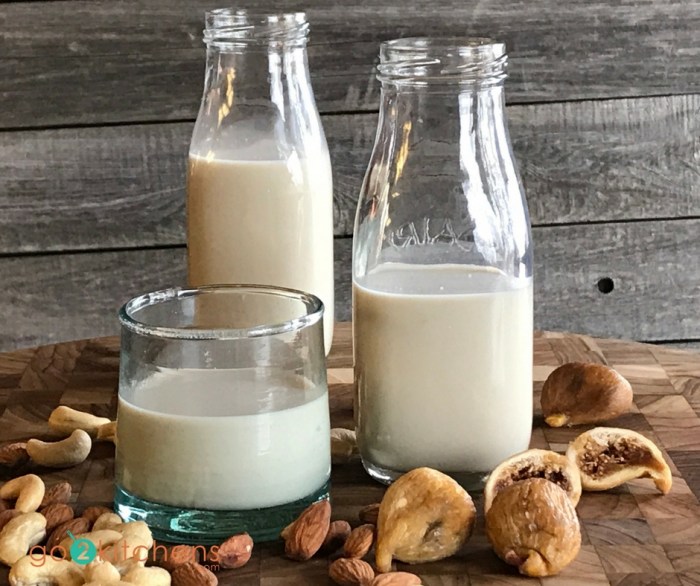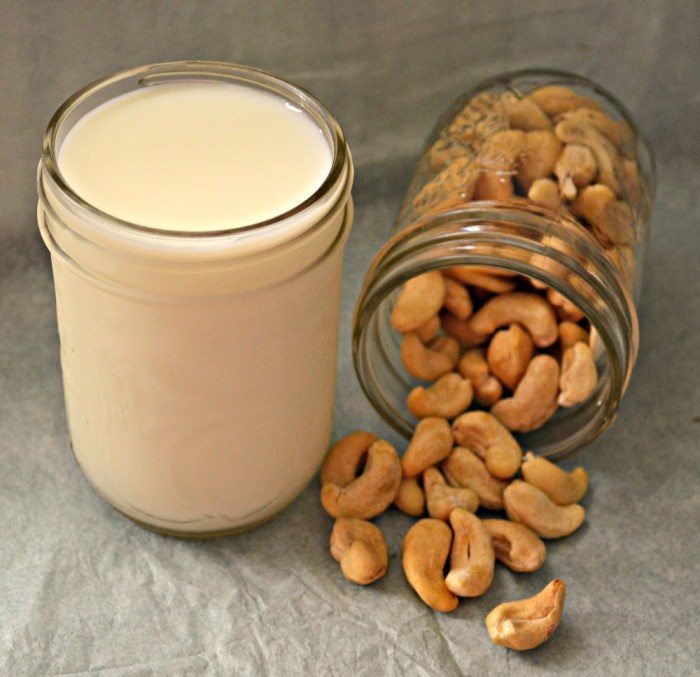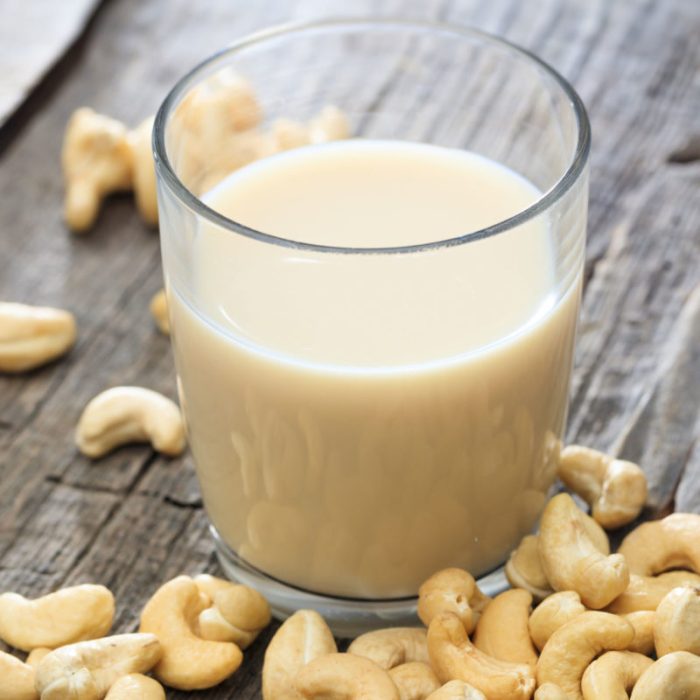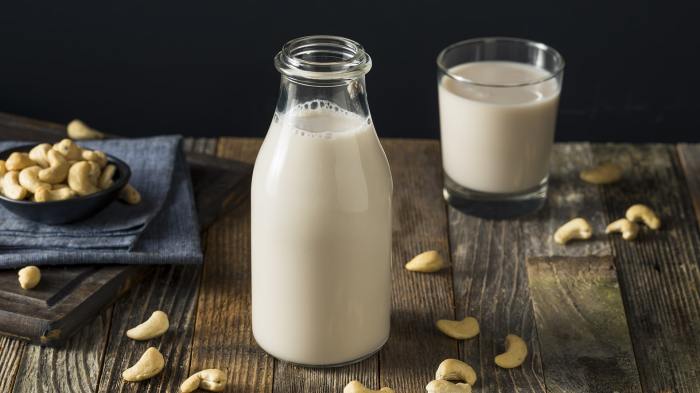Cashew milk recipe is a popular choice for those seeking a creamy, plant-based alternative to dairy milk. This versatile beverage boasts a rich, nutty flavor and is packed with nutritional benefits. Cashew milk can be enjoyed on its own, used in smoothies, soups, sauces, and even as a dairy-free substitute in baking.
The process of making cashew milk from scratch is surprisingly simple, requiring only a few basic ingredients and a blender.
Whether you’re looking for a healthy and delicious addition to your diet or simply want to explore the world of plant-based milk alternatives, cashew milk is a fantastic option. With its smooth texture, mild flavor, and impressive nutritional profile, it’s no wonder cashew milk has become a staple in many kitchens around the world.
Introduction to Cashew Milk

Cashew milk has emerged as a popular plant-based milk alternative, gaining traction among those seeking dairy-free options and embracing a more plant-based lifestyle. Its creamy texture, mild flavor, and versatility have contributed to its widespread appeal.Cashew milk offers a range of nutritional benefits.
It is a good source of vitamins and minerals, particularly manganese, which is essential for bone health and metabolism. It is also naturally low in calories and fat, making it a suitable choice for those looking to manage their weight.
Nutritional Benefits of Cashew Milk
Cashew milk is a rich source of several essential nutrients:
- Manganese:This mineral is vital for bone health, metabolism, and antioxidant activity. A single cup of cashew milk provides about 15% of the daily recommended intake of manganese.
- Magnesium:This mineral is important for muscle function, blood sugar control, and blood pressure regulation. Cashew milk provides a decent amount of magnesium, contributing to overall well-being.
- Copper:This mineral is essential for energy production, red blood cell formation, and iron absorption. Cashew milk offers a modest amount of copper, contributing to these vital functions.
- Phosphorus:This mineral is crucial for bone health, energy production, and cell function. Cashew milk provides a significant amount of phosphorus, supporting these essential bodily processes.
Versatility of Cashew Milk
Cashew milk’s versatility makes it a valuable ingredient in various recipes. It can be used as a base for smoothies, soups, and sauces, adding a creamy texture and mild flavor. It also serves as a substitute for dairy milk in coffee, tea, and baked goods.
- Smoothies:Cashew milk’s creamy texture makes it an ideal base for smoothies, blending seamlessly with fruits, vegetables, and other ingredients.
- Soups:Its mild flavor allows it to complement a wide range of soup flavors, adding richness and creaminess without overpowering the other ingredients.
- Sauces:Cashew milk can be used to create creamy sauces for pasta, vegetables, and other dishes, offering a dairy-free alternative to traditional cream-based sauces.
- Coffee and Tea:Cashew milk can be added to coffee and tea, providing a creamy texture and a slightly sweet flavor.
- Baked Goods:Cashew milk can be used in place of dairy milk in cakes, muffins, and other baked goods, adding moisture and a subtle nutty flavor.
Basic Cashew Milk Recipe
This recipe provides a simple guide for making cashew milk from scratch, highlighting the essential steps of soaking, blending, and straining cashews. It also offers tips for adjusting the consistency and sweetness to suit your preferences.
Soaking Cashews
Soaking cashews before blending is crucial for softening them and making them easier to process into smooth milk. It also helps to reduce the bitterness and enhance their creamy texture.
- Rinse the cashews thoroughly under cold water to remove any debris or impurities.
- Place the cashews in a bowl and cover them with plenty of fresh water. Ensure the water level is at least an inch above the cashews.
- Let the cashews soak for at least 4 hours, or ideally overnight, in the refrigerator. This allows them to soften completely and absorb the water, resulting in a smoother and more flavorful milk.
Blending Cashews
Once the cashews are adequately soaked, it’s time to blend them into a creamy milk base. The blending process determines the consistency and texture of the final product.
- Drain the soaked cashews and transfer them to a high-speed blender. Add the desired amount of fresh water, typically a ratio of 1:3 (cashews to water) for a standard consistency.
- Blend the cashews and water on high speed for about 2-3 minutes, or until the mixture is completely smooth and creamy. The mixture should have a consistency similar to heavy cream.
- For a thinner milk, add more water during the blending process. Conversely, for a thicker milk, use less water.
Straining Cashew Milk
Straining the blended cashew mixture removes any remaining cashew particles and creates a smooth, consistent milk.
- Line a fine-mesh strainer or cheesecloth with a clean kitchen towel or muslin cloth. Place the strainer over a large bowl or pitcher.
- Pour the blended cashew mixture through the strainer, allowing the milk to drip into the bowl. Use a spoon to gently press the remaining cashew pulp against the strainer to extract as much milk as possible.
- Discard the cashew pulp or save it for other uses, such as making cashew cheese or adding it to smoothies.
Adjusting Consistency and Sweetness
The consistency and sweetness of cashew milk can be adjusted to suit your preferences.
- For a thinner milk, add more water to the blended mixture before straining. For a thicker milk, use less water or blend the mixture for a longer time.
- To sweeten the milk, add a sweetener of your choice, such as maple syrup, honey, agave nectar, or dates. Adjust the amount to your desired sweetness level.
- Cashew milk can be stored in the refrigerator for up to 4 days. It is recommended to shake the milk before each use to ensure it is well-mixed.
Variations and Flavor Profiles

The basic cashew milk recipe provides a neutral foundation, but you can easily transform it into a variety of flavors. From sweet to savory, the possibilities are endless, and you can tailor the taste to your preferences. This section will explore some popular variations, including recipes and tips for creating your own unique cashew milk blends.
Explore the different advantages of turkey cutlet recipes that can change the way you view this issue.
Vanilla Cashew Milk
Vanilla is a classic addition to cashew milk, adding a touch of sweetness and a familiar comforting aroma. To create vanilla cashew milk, simply add a teaspoon or two of vanilla extract to the blended cashew mixture. You can also use vanilla bean for a more intense flavor, scraping the seeds and adding them to the milk.
For a sweeter vanilla cashew milk, you can add a tablespoon of maple syrup or honey to the blend.
Chocolate Cashew Milk
Chocolate cashew milk is a decadent treat that can be enjoyed as a warm drink or used in smoothies and desserts. To make chocolate cashew milk, add cocoa powder to the blended cashew mixture. The amount of cocoa powder will determine the intensity of the chocolate flavor.
For a richer chocolate flavor, use unsweetened cocoa powder and add a sweetener like maple syrup or honey. For a lighter chocolate flavor, use Dutch-processed cocoa powder, which has a milder flavor.
Cinnamon Cashew Milk
Cinnamon adds warmth and spice to cashew milk, making it a perfect choice for cold weather. To create cinnamon cashew milk, add a teaspoon or two of ground cinnamon to the blended cashew mixture. You can also add a pinch of nutmeg or cardamom for additional flavor.
For a sweeter cinnamon cashew milk, add a tablespoon of maple syrup or honey to the blend.
Spiced Cashew Milk
Beyond vanilla, chocolate, and cinnamon, you can explore a world of spices to enhance your cashew milk. Experiment with different combinations to create your own unique flavor profiles. Here are some suggestions:
- Cardamom and ginger:This combination offers a warm and slightly spicy flavor. Add a pinch of each spice to the blended cashew mixture.
- Nutmeg and cloves:This combination creates a warm and comforting flavor, reminiscent of holiday baking. Add a pinch of each spice to the blended cashew mixture.
- Turmeric and black pepper:This combination has a slightly earthy and spicy flavor, and is known for its anti-inflammatory properties. Add a pinch of each spice to the blended cashew mixture.
Sweetened Cashew Milk
While plain cashew milk is naturally slightly sweet, you can enhance its sweetness by adding sweeteners. Here are some common sweeteners to consider:
- Maple syrup:Maple syrup is a natural sweetener with a delicate caramel flavor.
- Honey:Honey is another natural sweetener with a variety of flavors, depending on its source.
- Agave nectar:Agave nectar is a natural sweetener with a mild flavor and a high fructose content.
- Dates:Dates are a natural sweetener with a rich, caramel flavor. You can add a few pitted dates to the blender for a subtle sweetness.
Cashew Milk from Different Cashews
The type of cashews you use can also affect the flavor of your cashew milk. For example, roasted cashews will produce a richer, nuttier flavor than raw cashews. You can also experiment with different types of cashews, such as:
- Whole cashews:Whole cashews will produce a smooth and creamy cashew milk.
- Cashew pieces:Cashew pieces will produce a slightly thicker and chunkier cashew milk.
- Salted cashews:Salted cashews will add a salty flavor to your cashew milk.
Cashew Milk in Recipes

Cashew milk’s creamy texture and mild flavor make it a versatile ingredient that can be used in a wide range of recipes. Its ability to blend seamlessly with other flavors allows it to shine in smoothies, soups, and sauces, adding richness and a touch of elegance to each dish.
Using Cashew Milk in Smoothies
Cashew milk provides a creamy base for smoothies, complementing both sweet and savory blends. Its neutral flavor allows the other ingredients to shine through.
- Tropical Green Smoothie: Blend cashew milk with spinach, mango, pineapple, and a touch of honey for a refreshing and nutritious smoothie.
- Berry Blast Smoothie: Combine cashew milk with frozen berries, banana, and a scoop of protein powder for a post-workout treat.
- Chocolate Peanut Butter Smoothie: Blend cashew milk with chocolate protein powder, peanut butter, and a banana for a decadent and satisfying smoothie.
Using Cashew Milk in Soups
Cashew milk adds a velvety texture and a subtle nutty flavor to soups, especially creamy varieties.
- Creamy Tomato Soup: Use cashew milk instead of heavy cream for a lighter and more flavorful tomato soup.
- Roasted Butternut Squash Soup: Blend roasted butternut squash with cashew milk, spices, and a touch of maple syrup for a comforting and flavorful soup.
- Creamy Mushroom Soup: Sauté mushrooms with onions and garlic, then blend with cashew milk, vegetable broth, and herbs for a rich and savory soup.
Using Cashew Milk in Sauces
Cashew milk can be used to create creamy and flavorful sauces for pasta, vegetables, and more.
- Creamy Pesto Sauce: Blend cashew milk with fresh basil, pine nuts, garlic, and Parmesan cheese for a rich and flavorful pesto sauce.
- Cashew Alfredo Sauce: Combine cashew milk with nutritional yeast, garlic powder, and a touch of lemon juice for a dairy-free Alfredo sauce.
- Creamy Mushroom Sauce: Sauté mushrooms with onions and garlic, then blend with cashew milk, vegetable broth, and herbs for a rich and savory mushroom sauce.
Substituting Cashew Milk for Dairy Milk
Cashew milk can be used as a substitute for dairy milk in various recipes, providing a creamy and allergen-friendly alternative.
- Baking: Cashew milk can be used in cakes, muffins, and cookies, adding a subtle nutty flavor.
- Cereal: Pour cashew milk over your favorite cereal for a creamy and satisfying breakfast.
- Coffee and Tea: Use cashew milk to create a creamy latte or to froth for a delicious cappuccino.
Storage and Shelf Life

Homemade cashew milk, with its delightful creamy texture and versatility, can be enjoyed for several days if stored properly. Understanding the optimal storage methods and recognizing signs of spoilage ensures you make the most of your homemade cashew milk.
Refrigerator Storage
Properly storing cashew milk in the refrigerator is crucial for preserving its freshness and extending its shelf life. To ensure the best results, follow these guidelines:
- Store your homemade cashew milk in an airtight container, such as a glass jar or a reusable container with a secure lid.
- Refrigerate the cashew milk promptly after making it, ideally within a few hours of preparation. This helps to prevent bacterial growth and maintain its quality.
- Place the container in the refrigerator, avoiding direct contact with other foods that might impart strong flavors or odors.
Shelf Life
Cashew milk, when stored correctly in the refrigerator, generally has a shelf life of 3 to 5 days. However, it’s important to be aware of potential signs of spoilage.
Signs of Spoilage
- Off-odor:A sour or fermented smell indicates spoilage. Cashew milk should retain its natural, slightly nutty aroma.
- Changes in Texture:Spoiled cashew milk might develop a thicker consistency or separate into layers, unlike the smooth, homogeneous texture of fresh milk.
- Color Alteration:While cashew milk typically has a light, creamy color, spoiled milk might appear discolored, perhaps with a slight yellowing or a gray tinge.
- Taste:The most reliable indicator of spoilage is an off-taste. If your cashew milk tastes sour, bitter, or otherwise unpleasant, it’s best to discard it.
Preserving Freshness
While homemade cashew milk generally lasts for a few days, you can employ a few techniques to further extend its freshness:
- Use Fresh Ingredients:Start with high-quality, fresh cashews for the best flavor and longevity.
- Sterilize Equipment:Ensure your blender and other utensils are thoroughly cleaned and sanitized before preparing the cashew milk.
- Store in Small Batches:If you anticipate using cashew milk over an extended period, consider making smaller batches to reduce the risk of spoilage.
- Freeze for Longer Storage:For extended shelf life, you can freeze your homemade cashew milk. Pour it into freezer-safe containers, leaving some space for expansion. Frozen cashew milk can last for up to 3 months, though it may slightly separate upon thawing. When thawing, gently stir the milk to restore its smooth consistency.
Nutritional Comparison
Cashew milk is a popular plant-based milk alternative, but how does it stack up against other options in terms of nutrition? This section delves into the nutritional profile of cashew milk and compares it to other plant-based milks, highlighting its potential benefits and drawbacks.
We will also discuss how cashew milk can fit into various dietary needs.
Nutritional Profile Comparison, Cashew milk recipe
Comparing the nutritional profiles of different plant-based milks can help you make informed choices based on your individual dietary needs. Here’s a breakdown of the nutritional content of cashew milk compared to other popular plant-based milk alternatives:
| Milk Type | Calories (per cup) | Fat (per cup) | Protein (per cup) | Calcium (per cup) | Vitamin D (per cup) |
|---|---|---|---|---|---|
| Cashew Milk (unsweetened) | 25 | 2.5g | 1g | 45mg | 0IU |
| Almond Milk (unsweetened) | 30 | 2.5g | 1g | 45mg | 0IU |
| Soy Milk (unsweetened) | 80 | 4g | 8g | 300mg | 0IU |
| Oat Milk (unsweetened) | 120 | 5g | 3g | 300mg | 0IU |
| Coconut Milk (unsweetened) | 55 | 5g | 1g | 20mg | 0IU |
As you can see, cashew milk is relatively low in calories and fat compared to other plant-based milks. It’s also a good source of calcium, though it lacks vitamin D.
Potential Benefits and Drawbacks
Benefits
- Low in Calories and Fat:Cashew milk is a good choice for those looking to manage their calorie and fat intake.
- Good Source of Calcium:Cashew milk is fortified with calcium, which is essential for strong bones and teeth.
- Allergen-Friendly:Cashew milk is naturally free from common allergens like dairy, soy, and gluten, making it suitable for individuals with these sensitivities.
- Pleasant Flavor:Cashew milk has a mild, slightly sweet flavor that many find appealing.
Drawbacks
- Low in Protein:Cashew milk is relatively low in protein compared to other plant-based milks like soy milk.
- Limited Nutritional Value:Cashew milk is not a significant source of vitamins and minerals, unlike some other plant-based milk alternatives.
- Potential for Allergies:While less common than other nuts, some individuals may be allergic to cashews.
- Environmental Concerns:Cashew production can contribute to deforestation and water usage, especially in some regions.
Impact on Various Dietary Needs
Vegan and Vegetarian Diets
Cashew milk is a great addition to vegan and vegetarian diets as a dairy-free milk alternative. Its mild flavor makes it versatile for use in various recipes, from smoothies and coffee to sauces and desserts.
Lactose Intolerance
For individuals with lactose intolerance, cashew milk offers a delicious and safe alternative to dairy milk. It’s free from lactose, making it easy to digest without any discomfort.
Weight Management
Cashew milk’s low calorie and fat content can be beneficial for those managing their weight. It can be used as a substitute for higher-calorie dairy milk in various recipes and beverages.
Diabetes
Cashew milk is generally considered safe for individuals with diabetes, but it’s essential to choose unsweetened varieties. Sweetened versions can significantly impact blood sugar levels.
Other Considerations
While cashew milk is a nutritious and versatile choice, it’s important to note that it may not be suitable for everyone. Individuals with cashew allergies should avoid it. It’s also worth considering the environmental impact of cashew production when making dietary choices.
Outcome Summary: Cashew Milk Recipe
Making your own cashew milk is a rewarding experience, allowing you to control the ingredients and create a truly customized beverage. From the basic recipe to the exciting flavor variations, cashew milk offers endless possibilities for culinary creativity. Whether you’re a seasoned chef or a beginner in the kitchen, this simple and versatile recipe is sure to become a favorite.
